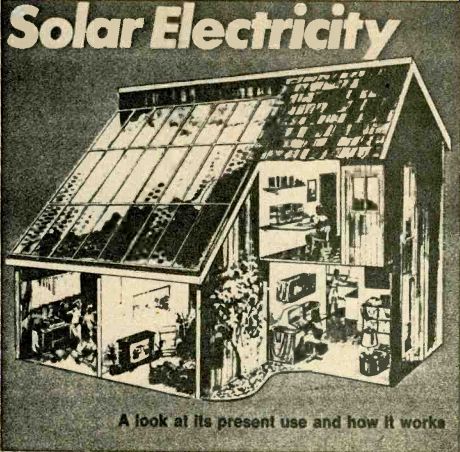
THE SOLAR CELL, or photovoltaic cell, makes a direct conversion from sunlight (solar energy) to electricity. No fossil fuel is required. Moreover, photovoltaics are safe and nonpolluting and are manufactured from materials in relatively abundant supply. Manufacturing costs are high. but declining steadily, while other methods of generating electricity involve energy costs that are rising sharply. A hope of the U. S. Department of Energy is to reduce the cost of producing electricity with photovoltaics to 50 cents per peak watt by the mid-80's. Additionally, photovoltaics require no moving parts and minimal maintenance. Associated components have a long life and no waste products are generated.

Fig. 1. A load connected between the N and P junctions will receive
current flow when light photons hit the N junction.
Solar Radio. Photovoltaic supplies are used extensively in the radio-communication services, such as for repeater, relay and rebroadcast stations that must be mountain-top located or located at a remote site where there is no source of power. The two-way radio services in 'particular can now make use of repeater sites at high locations where there is no convenient power.
Weak signals from mobiles can he picked up by the receiver and then retransmitted to obtain a reliable coverage over a much larger area. High locations permit a greater separation between relay stations of a point-to-point system and more economical operation.
TV and FM broadcast signals can be picked up and rebroadcast from high locations to obtain extended and better coverage into remote areas.
Radio station WBNO. Bryan, Ohio is the first AM radio station to operate with a photovoltaic power system. This project is sponsored by the U.S. Dept. of Energy and managed by the MIT Lincoln Laboratory. The solar system has a 15 kilowatt peak rating. and delivers 128-volts DC to the station.
Power is supplied by 800 photovoltaic modules employing 42 cells per module. This photovoltaic power system keeps 60 lead-acid cells under charge.
Marine beacons, buoys and other navigation equipment can be powered with solar cells and associated batteries.
A number of railway signaling systems are now powered with photovoltaics.
" Sun City." In another project sponsored by the U.S. Dept. of Energy, a small Papago Indian settlement has become the site of the world's first village powered by a photovoltaic power. system. The village has a population of 95 and its location is 17 miles from the nearest available utility power. The solar array provides 3500 peak watts.
Basic Operation. The basic solar cell is a semiconductor diode. Most often, it is made of pure silicon properly doped to obtain a PN junction as seen in Fig. 1. The N-type silicon is doped with phosphorus, while the P-type silicon is doped with boron. The N-silicon has free electrons while the P-silicon has free-moving positive charges called holes. At the PN junction region, the charges neutralize and with no incident light, there is no charge motion.
The arrival of light-rays at the thin N-silicon layer permits a penetration of photons to the junction region. The light energy forces electrons out of the crystal structure. This motion of charges produces an output current when there is a load path connected between the positive P-silicon terminal and the negative N-silicon terminal. The current varies linearly with the amount of light striking the cell and the cross-sectional area of the cell. The absolute output current is also a function of the load resistance and the conversion efficiency of the cell.
If a solar cell is directed toward the sun at noon on a clear day, the energy striking that cell will be approximately 100 milliwatts per square centimeter.
This results in maximum current as demonstrated by the top response curve of Fig. 2. Note that a light level of 100 milliwatts per square centimeter is referred to as "1 sun." If the light level is reduced to 0.5 sun, corresponding to 50 milliwatts per square centimeter, the output current is halved.
The open circuit voltage of a silicon cell is approximately 0.57-volts. This corresponds to zero output current.
When the load connected to the cell is of a resistive value that results in a cell voltage of 0.45-volts, there is maximum power delivered to the load. As shown in Fig. 2, almost maximum current flows. A reduction in the load resistance below this value results in very little change in current. In fact, the solar cell can be short-circuited and there will be no damage or significant increase in the load current. This condition too is shown in Fig. 2, with the game current present from right above the knee of the curve over to the zero voltage value.
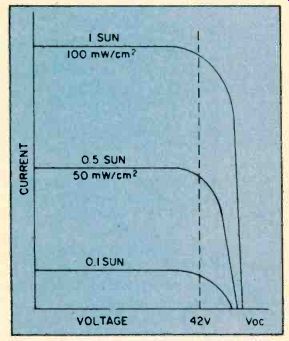
Fig. 2. Response of solar cell. Current is reduced in proportion to
light intensity. One Sun yields 100 milliwatts maximum.
In practice then, the voltage produced by a single silicon solar cell is between 0.4 and 0.45-volts. The size and shape of the cell has nothing to do with this value. The level of the output current as a function of a given light intensity is related directly to the cell area regardless of the shape of the cell, be it circular, semicircular, rectangular or any other configuration. Under the illumination of 1 sun, a typical 3-inch diameter solar cell will produce an output current of 1.2 amperes at a voltage of 0.45. A similar 2 1/4-inch diameter cell (about half of the area of the previous one) will provide an output current of 550 milliamperes.
The efficiency of a solar cell is the ratio of the electrical power output over the light power input:
% Efficiency =Power output/power input X 100
Efficiency is important and determines the electrical power output that can be obtained for a cell of a given size. The greater the efficiency, the more power that can be obtained with a solar panel of a given dimension. Typical efficiencies of modern silicon solar cells fall between ten and twelve percent.
Series and Parallel Connections.
Higher voltage and higher current capability can be obtained with appropriate series and parallel connections of solar cells. The voltage is increased when cells are connected in series just as there is a voltage increase when batteries are connected in series. Also, there is a higher current capability when solar cells are connected in parallel just as the current capability is increased when batteries are connected in parallel. Four, 0.4-volt solar cells connected in series will provide an output voltage of 1.6-volts (4 x 0.4). Four, 1.2 ampere cells connected in parallel will result in a current capability of 4.8 amperes (4 x 1.2). If 16 of these 0.4-volt and 1.2 amperes cells are connected in series-parallel, as shown in Fig. 3, the output will be 1.6-volts with a current capability of 4.8 amperes.
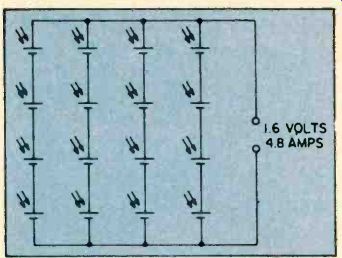
Fig. 3. Connecting solar cells in series increases voltage and in
parallel increases current. Series/parallel steps up both.
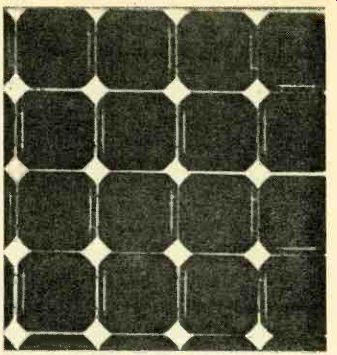
Fig. 4. Modern hi-density solar panel in frame. Model consists of
sixty-four square cells producing up to 34 watts of power.
Photovoltaic Solar Panels. A solar photovoltaic panel is the result when many solar cells are mounted in a series-parallel arrangement on a frame. Note that the solar panel of Fig. 4 consists of 64 square cells. The Solarex HE-51 21-inch by 21-inch solar panel provides a peak power capability of 34 watts. Its rating is 2.1 amperes at 14-volts nominal. The response of the panel is shown in Fig. 5. Based on the average insulation in the United States, the panel is capable of providing approximately 63 ampere-hours of electricity per week.
When a higher voltage is desired, panels can be connected in series just as individual solar cells. For example, two such panels in series would provide an output of 28-volts. Two of them connected in parallel would provide a current capability of 4.2 amperes.
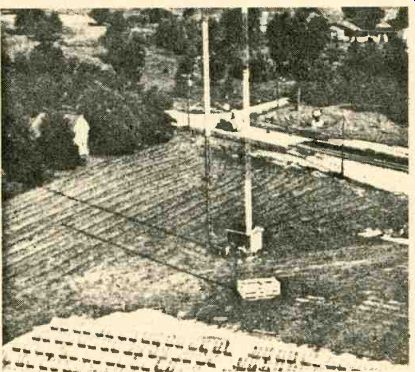
The transmitter of AM radio station WBNO in Bryan, Ohio is said to
be the first using photovoltaic power. An array of 800 modules containing
33,600 cells produce 15 kilowatts peak and delivers 128-volts DC to
the station.
Sixty lead-acid cells are kept effectively charged by this system.
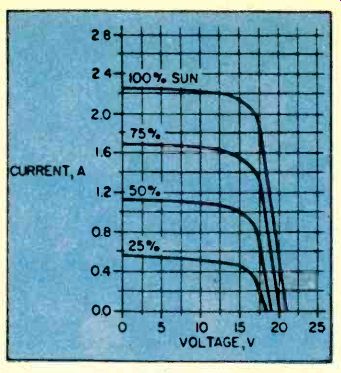
Fig. 5. A performance chart of the solar panel in Fig. 4. Note that
voltage output remains at constant nominal 14-volts.

Fig. 6. Blocking diode prevents battery from discharging into solar
panel when light is absent or at a very low level.
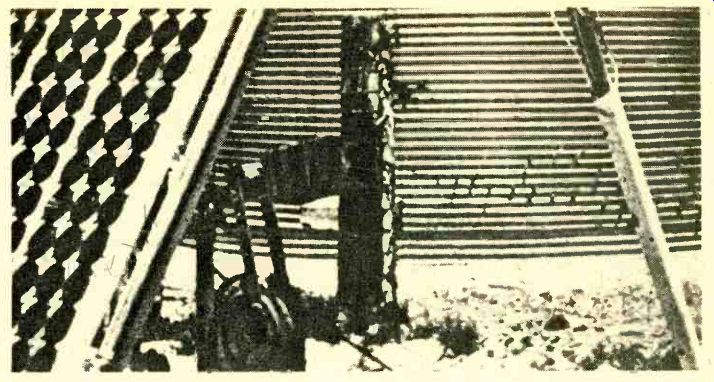
----- -This water pump, miles from a power source, draws its electrical
power from a bank of solar cells. Such pumps can transform arid deserts
into arable, productive farmland.
Complete Power Supply. A complete solar power supply, including battery and load, is shown in Fig. 6. In sunlight, the solar panel charges the battery through a blocking diode. The load is connected across the battery.
In darkness and at low light levels, the battery supplies the necessary energy to the load on a continuous basis. Theoretically, the solar panel must be capable of supplying at least the same number of ampere-hours to the battery as the load demands from the battery. Of course, in practice, system losses and other variables require that the solar panel and battery capabilities be greater than the actual load demand.
The blocking diode is an important part of the charging system. In darkness and low illumination, the battery voltage could exceed the solar panel voltage. Without the diode in the circuit, the battery would then discharge into the solar source. Under the condition of high battery voltage and low charge voltage, the diode is reverse-biased. Consequently, the anode becomes more negative than the cathode and the discharge path into the panel from the battery is opened.
The solar panel must supply the total power required by the load. This it must do when sunlight is available.
The battery function is to smooth out the power delivered to the load as the sunlight varies, and to supply power when the light level is low.
An additional factor that must be known is the number of peak sun-hours per day for a mounting site. This information is available from appropriate charts and tables. Peak sun-hours in the southwest, for example, would be greater than along the east coast. Consequently, the ampere-hour capability would require more solar panels at a mounting site in the east as compared to one in the southwest. The average peak sun hours and the daily load in ampere-hours can be used to determine the total current in amperes that must be supplied by the solar system according to the following relationship: Amps-Ampere-hours per day Peak sun hours As a safety margin, the amperes required should be a figure which is at least 20 % greater than the above calculation. The capacity of the battery is usually made substantially greater than the above ampere-hour figure. Thus the battery should be capable of supplying the necessary power for an extended period of time, perhaps a week, assuming that illumination at the site could be low because of poor weather conditions extending over such a period of time.
A Typical Example. Assume that a radio transceiver was to be powered by a solar panel. On transmit, the current demand is 1 ampere; on receive, 0.1 ampere Over a period of a day (24 hours) the intermittent operation of the transmitter involves a total time period of 8 hours. The receiver is in operation for the remainder of the 24 hour period.
Consequently, the ampere-hours (Ah) drawn by the transmitter and receiver are:
Transmit = 1 X 8 = 8 Ah
Receive = 0.1 X 16 = 1.6 Ah
The total demand is 9.6 ampere-hours (8 + 1.6). Assume at the site of the solar panel there are an average of 4 peak sun hours. Consequently, the current (I) that must be made available by the solar power system becomes:
I= Ampere-hours /Peak Sun Hours
I = 9.6/4
I = 2.4 amperes
Allowing a 25 % safety factor, the solar system should be capable of delivering an average current I_av of:
Average Current =
= 2.4 + (0.25 X 2.4)
I_av = 3 amperes
If the transceiver operates at 12 volts, the rating of the solar panel should be about 14-volts at 3 amperes.
In this arrangement, on an average basis, the ampere-hours delivered by the solar panel would be 12 (3 X 4), while the average demand of the transceiver would be 9.6 ampere-hours.
Conclusion. In the next decade, the photovoltaic power supply will become increasingly popular. This is especially so in the field of radio communications and wherever low-powered electricity is required. Further along will be the high-powered systems now costly and experimental, but with a bright future in a world of renewable energy scarcity.